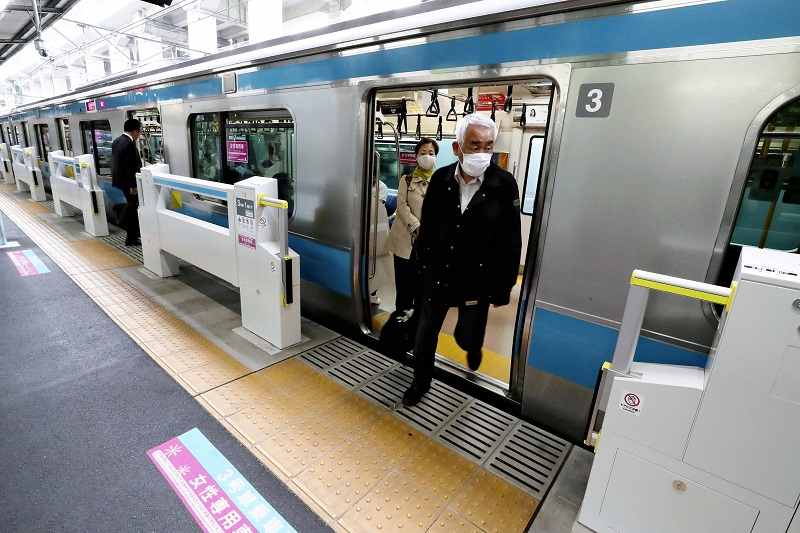
The latest type of automatic platform doors, set up in February, are seen at JR Kami-Nakazato Station in Kita Ward, Tokyo, in late May.
15:23 JST, June 20, 2021
Riding the train is likely to cost a little bit more in the near future as the transport ministry is looking into using an additional tariff to help pay for accessibility improvements at stations.
The additional fee, with a charge of less than ¥10 per ride under consideration, will likely apply to Japan Railways and other major private railways operating in the Tokyo, Osaka and Nagoya metropolitan areas, according to sources.
The Land, Infrastructure, Transport and Tourism Ministry will discuss the issue with the relevant railway operators, with the aim of introducing the fees two years later.
This fee will provide revenue for the railway operators to use only for installing or maintaining accessibility-related facilities, such as elevators, slopes and automatic platform doors.
To ensure transparency, the operators will be obligated to disclose information on the amount of this revenue and their progress in installing such facilities.
Railway operators are required to apply to the ministry for approval when they plan to make major changes in fares or establish new railroad fees. The ministry plans to lay out the details of the new railroad fee to operators. If the operators choose to introduce the tariff, they will then apply to the ministry individually after deciding for which lines the new charges will be in place.
Costs to set up accessibility-related facilities are borne by railway operators and the central and local governments, with the central government spending about ¥1.3 billion in fiscal 2020.
The ministry hopes to expand accessibility at stations, as it is necessary to improve safety and convenience for all passengers. In September 2018, an expert panel set up by the transport ministry made a proposal to charge passengers to pay for the costs of accessibility-related facilities.
Now, as the burden on operators is becoming heavier, especially in regional areas where the number of railway riders is unlikely to increase due to depopulation, the government decided it was necessary to have passengers take on a share, the sources said.
The plan envisions train passengers in urban areas paying the tariff for the use of railways so that their portion of the central government budget can be reallocated to regional areas.
As of the end of March 2020, escalators or elevators were set up at 91.8% of stations used by more than 3,000 passengers per day, and automatic platform doors were installed at 22.4% of these.
In December, the ministry released fiscal 2021-25 targets for installing accessibility-related facilities at stations. Considering the aging population and the about 3,000 accidents annually from falls off platforms, the targets include accelerated efforts to set up automatic platform doors and the construction of multiple elevators.
"Society" POPULAR ARTICLE
-

M4.9 Earthquake Hits Tokyo, Neighboring Prefectures
-

Israeli Tourists Refused Accommodation at Hotel in Japan’s Nagano Pref., Prompting Protest by Israeli Embassy and Probe by Prefecture
-

M7.5 Earthquake Hits Northern Japan; Tsunami Waves Observed in Hokkaido, Aomori and Iwate Prefectures
-

Tsukiji Market Urges Tourists to Avoid Visiting in Year-End
-

High School in Kyoto Says Students Shoplifted during Recent School Trip to Bali, Indonesia
JN ACCESS RANKING
-

Tokyo Economic Security Forum to Hold Inaugural Meeting Amid Tense Global Environment
-

Keidanren Chairman Yoshinobu Tsutsui Visits Kashiwazaki-Kariwa Nuclear Power Plant; Inspects New Emergency Safety System
-

Imports of Rare Earths from China Facing Delays, May Be Caused by Deterioration of Japan-China Relations
-

University of Tokyo Professor Discusses Japanese Economic Security in Interview Ahead of Forum
-

Japan Pulls out of Vietnam Nuclear Project, Complicating Hanoi’s Power Plans























